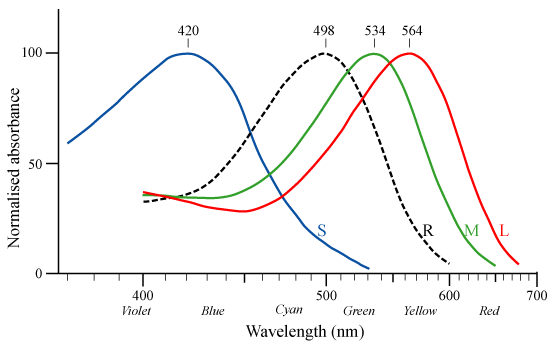|
Color vision is a highly-debated gray area that lies somewhere between physics and psychology. As we have just seen, the underlying source of color can clearly be defined by physics. However, how does electromagnetic radiation at varying wavelengths make the transition to being what humans call color? Based on our current knowledge, there is no observable physical explanation (in our brains or elsewhere) as to how a 650 nm ray of light becomes "red". As it stands, there's no proof that one day you couldn't wake up with your visible-color spectrum flipped. For more information on the debate between physics and psychological interpretation of sensory experiences, search for the term "qualia". Now back to the physics (this is a physics webpage after all)... The point is, color is a purely subjective experience that would not exist without eyes to see it. We can only understand color based on how we see color, even though other animals can see it differently. The human eye contains both rod cells and cone cells to interpret light. Rod cells interpret lower levels of light than cone cells; they also do not see color. In light environments, cone cells become activated and replace the rod cells as the primary source of visual information. Cone cells are the photoreceptors used to discriminate color. The human eye contains three different types of cone cells which interpret their own ranges of electromagnetic wavelengths. These three cone cells are often oversimplified as the "blue, green and red" cone cells when, in fact, they each cover a range of colors. Each cone cell's sensitivity to light is distributed as a bell curve over a range of wavelengths. The three cone cells are commonly characterized as the "blue, green and red" cone cells based on the color of their peak wavelength sensitivity, as shown in this chart (the dashed line represents rod cells):  Picture from: http://en.wikipedia.org/wiki/Color Any color that can be interpreted by the three human cone cells can be drawn as a vector in a three-dimensional representation of human color space. In this three-dimensional model, each axis represents one of the three types of cone cells. Once a color is drawn as a vector in human color space, it can be broken down as a projection onto each of the three axes. The magnitude of each projection represents the degree to which a set of cone cells is stimulated. The human color space is shown here, where S, M, and L are the short-wavelength cones, the medium-wavelength cones, and the long-wavelength cones, respectively:  Picture from: http://en.wikipedia.org/wiki/Color | |
| << What is Color? | Color Blindness >> |